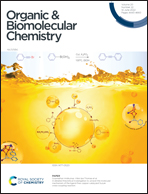A detailed theoretical investigation to unravel the molecular mechanism of the ligand-free copper-catalyzed Suzuki cross-coupling reaction†
Abstract
The Suzuki–Miyaura coupling (SMC) represents a very efficacious method for constructing C–C bonds in organic synthesis. The ligand-free variants of SMC have been grabbing attention these days. Despite this momentousness, the mechanistic details of the ligand-free variants are scant in the literature. Herein, we have carried out a detailed mechanistic investigation into the ligand-free Cu-catalyzed SMC of unsaturated organic halides with aryl boronic acid with the aid of density functional theory (DFT) calculations employing the conductor-like polarizable continuum model (CPCM) method. The present study elucidates that in the absence of ancillary ligands on the metal, the substrates, base, and solvent molecules could act as pseudo-ancillary ligands to facilitate the cross-coupling reaction. The investigation further revealed that unsaturated halides like alkynyl halides/vinyl halides could act as good ancillary ligands for copper by forming a Cu–π intermediate and promoting a facile transmetalation process. However, regarding the oxidative addition and reductive elimination steps, a concerted pathway is observed contrary to Pd catalyzed Suzuki coupling, owing to the instability of Cu(III) species and the favourability of Csp2–Csp bond formation. In the whole set of mechanisms explored, oxidative addition/oxidative nucleophilic substitution was the rate-determining step in all the cases. A thermodynamically stable π-coordinated intermediate species where the substrate and base molecule are coordinated to the metal center is identified as the rate-determining species for the ligand-free Suzuki cross-coupling reaction. The presence of the aforesaid intermediate increases the energy span and consequently the activation barrier for the rate-determining step. This study unveiled a theoretical rationale for the high-temperature requirement in the ligand-free Cu-catalyzed SMC reaction.



 Please wait while we load your content...
Please wait while we load your content...